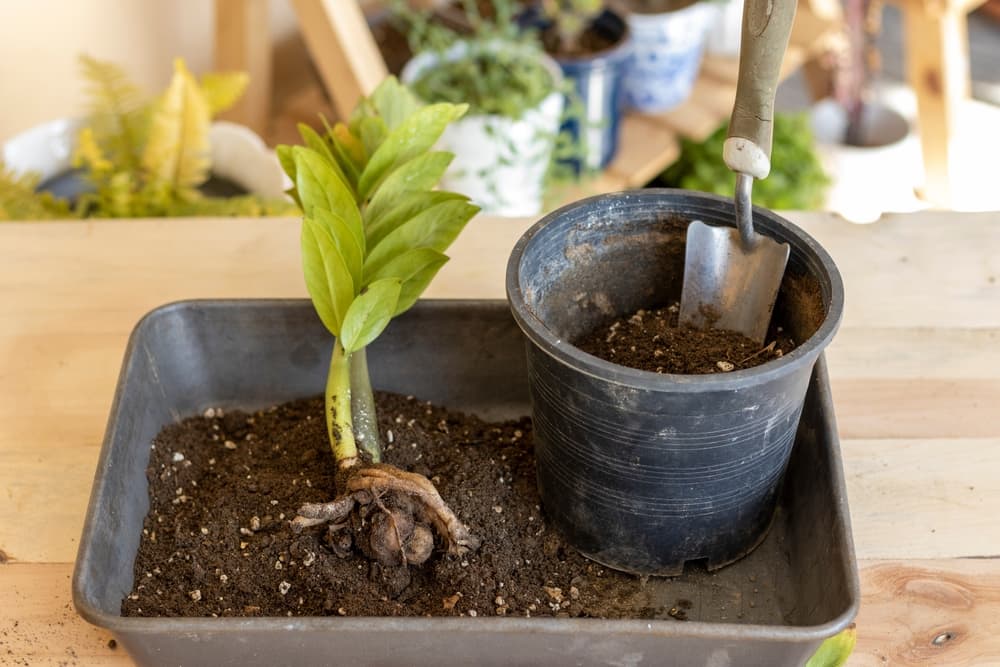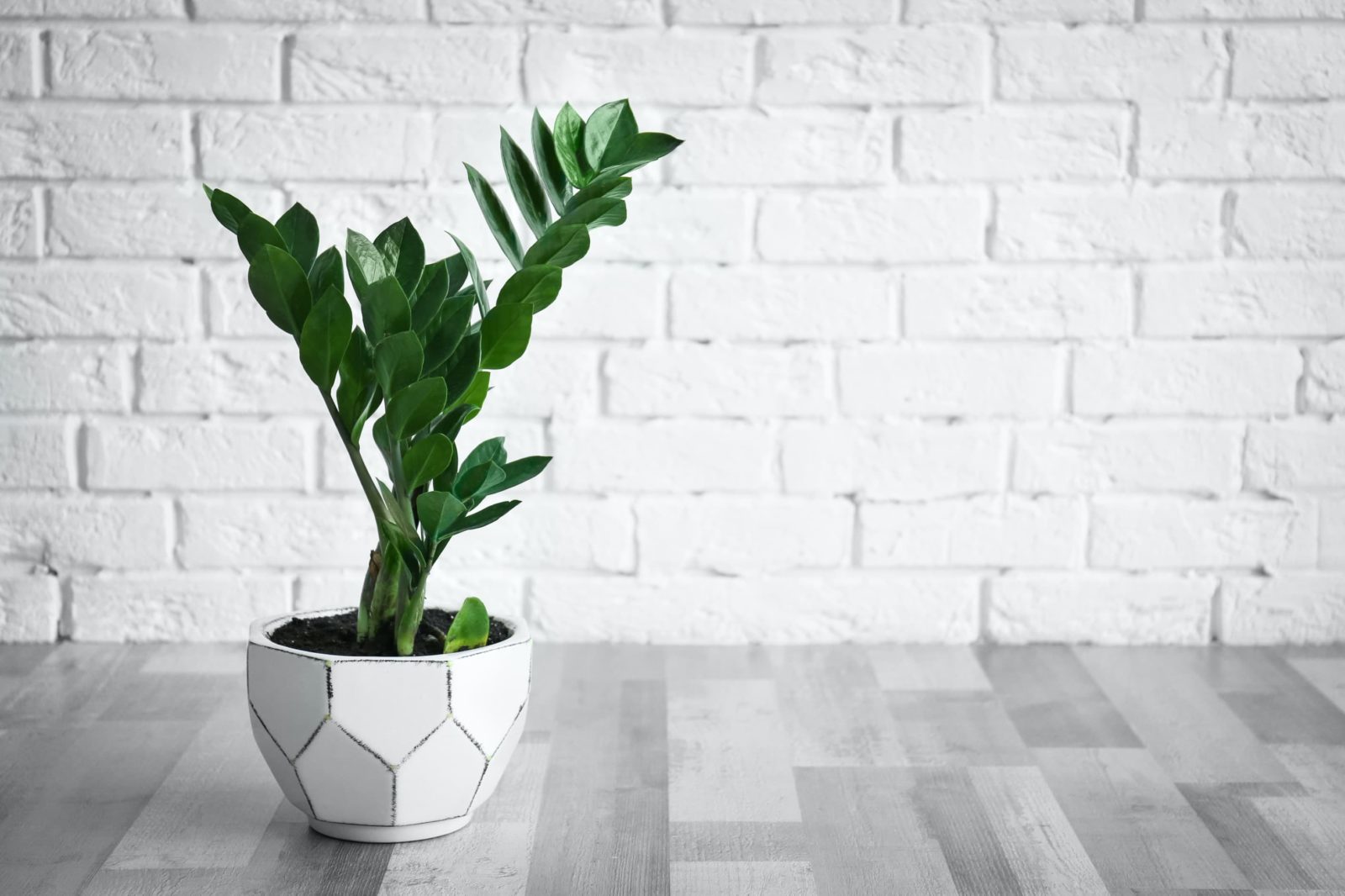HOUSEPLANTS > ZZ-PLANT

Elizabeth is a Permaculture Garden Designer, Sustainability Consultant and Professional Writer, working as an advocate for positive change. She graduated from the University of St. Andrews with an MA in English and Philosophy and obtained a Diploma in Applied Permaculture Design from the Permaculture Association.
Reviewed By COLIN SKELLY

Colin is a Horticulturist and Horticultural Consultant with experience in a range of practical and managerial roles across heritage, commercial and public horticulture. He holds the Royal Horticultural Society’s Master of Horticulture award and has a particular interest in horticultural ecology and naturalistic planting for habitat and climate resilience.
Contributions From JANE PERRONE

Jane Perrone is a Journalist turned Houseplant Expert who has over 25 years of experience. Jane published a book on Houseplants at the start of 2023 and is the founder of On The Ledge podcast, with more than 250 episodes to date. She is a member of the RHS Advisory Committee on Houseplants.
IN THIS GUIDE
ZZ PLANT GUIDES
Zamioculcas zamiifolia, as well as being a terrible tongue twister, is an evergreen perennial that works well as a houseplant because it is very tolerant of neglect.
Also known as ‘ZZ Plant’, ‘Zanzibar Gem’ and ‘Fern Alum’, this plant is excellent for those who don’t necessarily have the best track record when it comes to keeping houseplants alive.
Its large water-storing rhizomes mean that it is tolerant of a lack of watering, and it can thrive in a range of conditions inside your home, as Jane Perrone, houseplant expert, explains:
“I’d always recommend Zamioculcas zamiifolia to a beginner, as it is a fascinating plant that is really tough to kill.
“The only way you might kill it is if you are too generous with watering it. It’s a really nice plant, easy to grow and can take a lot of droughts.”
Overview
| Botanical Name | Zamioculcas zamiifolia |
| Common Name(s) | ZZ Plant, Zanzibar Gem, Fern Alum |
| Plant Type | Houseplant |
| Native Area | East African Tropics |
| Hardiness Rating | H1A |
| Foliage | Architectural, sprawling foliage |
| When To Sow | Year-Round |
Sunlight
Preferred
Full Sun
Exposure
Indoors
Size
Height
0.1 – 1M
Spread
Varies
Soil
Preferred
Free Draining Medium
Moisture
Well Drained
pH
Neutral
ZZ plant is an evergreen perennial plant native to the East African Tropics.1Zamioculcas zamiifolia. (n.d.). Kew Royal Botanic Gardens. Retrieved March 27, 2023, from https://powo.science.kew.org/taxon/urn:lsid:ipni.org:names:89402-1
It is thought to originate primarily in Tanzania and Kenya, but grows widely across Central Africa and the east African coast.
In its natural environment, it is found in rocky soil in lowlands and the foothills of Highland regions.

In its native range, it is habituated to (and can thrive) when exposed to long periods of very dry weather with sporadic torrential downpours.
‘Reservoirs’ within the plant allow it to rapidly store water, and draw upon it for long periods of time – making it highly tolerant of infrequent watering.
It has smooth, shiny green leaves that rise vertically, with 6-8 pairs of leaflets on each one.
One or two un-showy green and white flowers (like those of an arum) may appear among the leaf bases in summer, followed by white berries.
Why Grow Zamioculcas zamiifolia?
In recent years, ZZ plant has most certainly become more popular in homes and office spaces.
It is highly regarded for its strong architectural and dramatic form and is also prized for its ability to thrive with little water and in a range of different interior climate conditions.

If you are rather forgetful with your watering habits, you might find that this plant could even thrive when given infrequent watering.
It also grows relatively slowly, so there are few concerns that it will outgrow a space (especially if you are limited on this front).
Habitat & Growing Conditions
ZZ Plant can be great on coffee tables, on desks, or in other locations in interior design.
“The ZZ plant is the quintessential coffee table or desk plant for your office,” says Horticultural Consultant Colin Skelly.
“It will tolerate irregular watering, in fact, it will prefer this over overwatering. It will also tolerate anything but very strong light. A perfect plant for the beginner or those who think they always kill plants.”
Temperature
This is a plant that can grow in low light or much brighter conditions.
It requires temperatures above 8°C to survive – though typically a healthy plant should not be kept in conditions below 15°C – and it grows best in temperatures between 15-24°C.
Sunlight
ZZ plant can be slower to grow where there is not as much sunlight.
This means that bright light will generally lead to larger plants (with long leaves with leaflets that are up to 2-3 ft long).

However, where there is more light, more water will be needed – and it is best to avoid direct sunlight.
Due to its larger form, ZZ plant should be positioned where it has space above it to grow; it can look good on a table or desk display.
Humidity
The humidity levels that are typical for a domestic property should work well for this plant – but if the heating system is particularly drying, it may be a good idea to mist to increase air humidity.
Container Growing
In terms of the container you choose, it is essential to choose containers which have good drainage holes at the bottom.
ZZ plant can tolerate a lot, but it will not like having ‘wet feet’.
The container should allow water to drain freely.

A clay pot can be ideal because it will dry out more easily; a plastic pot (in addition to being a less eco-friendly choice) can increase water retention, which can potentially cause problems for the roots of this drought-tolerant plant.
Another reason that a clay pot could be a good idea is that it is heavier, so will be less likely to tip over as your ZZ Plant grows vertically.
Do not choose a pot that is oversized for your plant – aim for around an inch of space around the root system.
Pot up your plant once a year in early spring – this is especially important during the first 3-5 years of the plant’s growth.

Less frequent repotting will be required for more mature plants.
To fill the container, choose a well-draining potting mix; a homemade compost or leaf mould mix with plenty of sharp sand or grit mixed in.
Plant Care
ZZ Plant, as mentioned above, is extremely easy to care for.
Watering
If you have struggled before with houseplants due to lack of watering – you may have more luck with this plant because it will tend to survive even the most neglectful of indoor gardeners.
There is just one key thing to remember: the more light your ZZ plant gets, the more water it needs.
If your plant is positioned in lower light conditions, you should reduce your watering accordingly.

The main way that you could go wrong is simply by watering too much.
Less is more when it comes to watering this type of houseplant – one thing that ZZ plant most definitely won’t like is having too much water in the growing medium around its roots for too long.
Allow the growing medium to become dry at the top to the touch before watering again: simply poke a finger into the top of the pot or container.
If there is any moisture detectable, wait a little longer before you water again.
Note – a few lower leaves turning yellow is normal. However, if many leaves are yellowing, this may be a sign that you are watering too much.
Mulching
It can be a good idea to use grit or another soil cover on the top of the growing medium around your plants, to improve drainage and make sure that water does not pool on the surface around your plant.
This can also help prevent the growing medium from splashing up onto the lower leaves when you water.
You could also use a more decorative mulch such as shells or glass beads in order to tie your plants in with your interior design scheme.
Feeding
ZZ plant is a low-maintenance option and as long as you have used a relatively fertile growing medium, it does not necessarily have to be fertilised at all.
However, if your plant looks a little lacking in lustre, you can give it a boost.

Between April and August, feed the plant around once a month with a balanced, organic liquid fertiliser.
If the leaf tips turn brown, your plant does not usually need fertiliser; it is more likely that humidity is too low.
Mist your plant to raise the air moisture around your plant.
If the leaflets turn brown and are a bit damp to the touch, overwatering is usually the issue.
Pruning
You will not usually need to worry much about pruning your Zamioculcas zamiifolia.
Most of the time, you will just keep your plant looking good by cutting away any leaflets that turn yellow near the base of the vertical leaves.
Occasionally, you may also wish to prune out certain leaves in order to improve the overall appearance of your plant.
Some of the leaves will tend to grow vertically, while others may tend to arch over.
Cutting your plant to size at the tip will make it look odd, so it is best to cut off leaves that you do not like for the overall appearance of your plant at the base.
Propagation
Propagation of ZZ Plant is relatively easy and straightforward.
If you want more than one plant, you can simply purchase one and propagating from this plant will be easy enough to increase your stock.

You can propagate Z. zamiifolia by means of rhizome division, or through leaf cuttings.
Leaf cuttings (individual leaflets) are left to cure (dry) and then placed in a pot with a suitable growing medium – a plastic covering is used over this pot to retain moisture, and the wait begins for roots to form.
Note that it could take up to a year for successful rooting to take place.
It won’t take much work or effort on your part to keep your ZZ Plant looking good in your home for years to come – so even if you have struggled in the past to keep green things going, this could be an interesting and easy option to consider.
ZZ plant is a gateway to growing, which can allow even the botanically challenged to enjoy green inside their homes.
References
- 1Zamioculcas zamiifolia. (n.d.). Kew Royal Botanic Gardens. Retrieved March 27, 2023, from https://powo.science.kew.org/taxon/urn:lsid:ipni.org:names:89402-1

